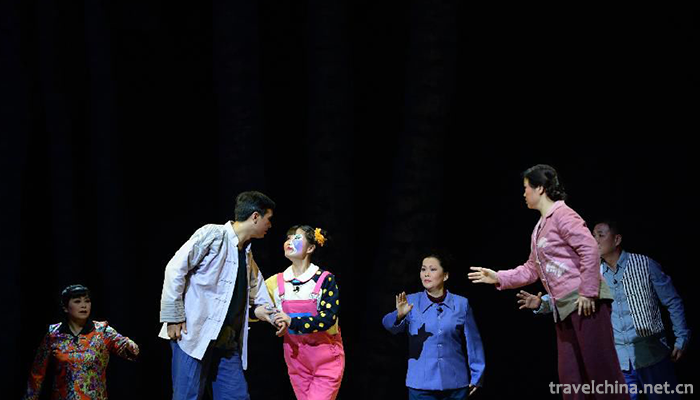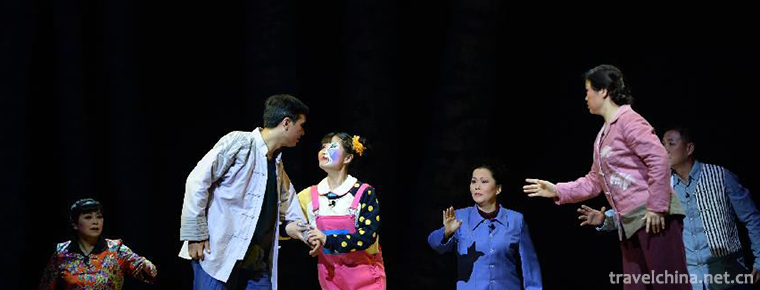Linear cavity
Linear cavity
Line-tune opera, also known as Line-score opera, is an ancient traditional opera in Shanxi Province. It first appeared in the Han and Tang Dynasties, and developed greatly. It flourished in the Song Dynasty. It has a history of more than 1000 years. It is a bright and dazzling flower in the hundred gardens of Chinese opera. According to textual research, the origin of the line cavity is Ruicheng in southern Shanxi, which was once popular in the triangle area bordering Jin, Qin and Henan. In the long-term development and evolution, influenced by Pu Opera, Qin Opera and other operas, Line Opera is popular with the masses, with its high and fresh style, graceful and lingering, rich in Lyric color.
On November 11, 2014, the Line Cavity was selected as the fourth batch of representative projects of national intangible cultural heritage with the approval of the State Council .
A Brief History of Plays
Line tune music appeared in the early Ming Dynasty, which was derived from "good calligraphy tune". In the course of its development, Pu Opera and Qin Opera had great influence. During the invasion of China by Japanese invaders, the line chamber suffered from bad luck and was almost extinct. In the spring of 1950, after liberation, the local government hired artists and appointed cadres to form a troupe of performers. In 1964, when leading comrades from central, provincial and local governments visited southern Shanxi Province and watched the performances of the Line Opera Troupe, they put forward the reform plan of "retaining the aria and employing people to perform". Later, the Yongle Line Opera Troupe was set up to perform in the front stage with actors instead of puppets.
Performing Arts
Line cavity, also known as "line drama", commonly known as "line Hu opera". Its role image resembles Tang figurines and Lai Baozi, and has the traces of Guo Tuo, so it has a long history. Heyang line puppets are 80 to 90 centimeters tall. At the beginning, they were flat and had no hands or feet. They were replaced by sleeve gowns. Five to seven lifting lines (head 3, hand 2, waist 1) were added to 13 for special needs, and the length of the line was about 1 meter (called "low line"); after the 1970s, the stage was renewed and the artists operated at high altitude, and "high line" appeared. After a long period of practice, artists have groped out eight techniques, such as lifting, plucking, hooking, picking, twisting, grabbing, flashing and shaking, so that they can make almost all kinds of life and dance movements and have a lifelike manner. The early stage was about 15 feet square, supported by wooden pillars and surrounded by mantles, with both sides going up and down. Six accompaniments, five dolls, visiting each other, should not be festive, vivid and lifelike.
Musical melody
The musical tunes of line tune can be divided into two categories: line tune and random play. There are adagio, 28, running water, scattered board and so on. Different professions have different singing methods. Accompanied instruments are set up with civil and military scenes. There are two kinds of drum boards in the martial field, namely, dry drum and blast drum. Dry drum is mainly used for singing accompaniment through the door, the drum tone is low and broad, close to the homophony of "violent" sound, mainly used for inter-action. In the opening and closing performances, the drummer holds the wooden cylinder board in his left hand while accompanying the singing, shaking and beating, and the sound is high and bright. There are three different size gongs, tied on a wooden frame, by the drummer one person to attack, two large shell board Hu mainly. After that, flute, erhu, monohu and plucked instruments were added. There are many lines of opera, the main representative of which are "Qingyi Tactics", "Zhonggu Tactics", "Hundred Treasure Boxes in Anger" and so on. After the establishment of the Line Opera Troupe, the more successful actors are Zhang Bucao, Guo Melan and so on.


-
2.International Jade City
International Yucheng is located in the south of Shifosi Town, Zhenping County, Henan Province, on the south side of Yuyuan Avenue, south to Liulu Highway, east to Erlong Road, north to Longxiang Road
Time 2019-01-13 -
3.Bo dance
Horqinbo dance, a primitive religious dance, is a form of Mongolian Bo (Shaman) "Xingbo" (Dancing God) and sacrifice. It is characterized by the combination of inspiration,
Time 2019-04-04 -
4.Daur Costume
The Daur nationality has a long history and agricultural culture in northern China. Daur garments are greatly influenced by Mongolian and Manchu nationalities.
Time 2019-04-22 -
5.Big flat tone
Da Ping Diao (also known as Ping Diao, Da You Bang and Da Bang Opera), one of the local traditional operas in Henan and Shandong Province, is one of the national intangible cultural heritage.
Time 2019-04-23 -
6.Liang Ping Wood New Year Print
Liangping Wood Printing New Year Painting belongs to Liangping's "Three Wonders" (Bamboo Curtain, New Year Painting and Lantern Opera), which is a kind of painting art drawn by the people in
Time 2019-05-13 -
7.Puning Ying Song
Puning Yingge is a traditional folk dance style widely spread in Puning City, Guangdong Province. It was created and compiled by Yitang people during the reign of Qianlong in the Qing Dynasty. It has
Time 2019-06-09 -
8.Qingxu Caimen Building
Qingxu Caimen Tower is a local traditional handicraft in Qingxu County, Shanxi Province. Xu Caimen Tower in Qing Dynasty is said to have originated in Tang Dynasty. During the festival, people gathere
Time 2019-06-11 -
9.Surface painting
Water and land painting Festival is a traditional religious painting. Originated in the Three Kingdoms Period, Buddhist monasteries prevailing from the Jin Dynasty to the Yuan, Ming and Qing Dynasties
Time 2019-06-15 -
10.Luocheng ancient town
Luocheng ancient town, known as "China's Noah Ark", is located in the northeast of Qianwei County, 60 kilometers away from Leshan City and 25 kilometers away from Qianwei county. There are seven ethnic groups, Han, Hui, Yi, man, Tibetan, Li and Miao.
Time 2020-10-15 -
11.Social security in Luzhou
By the end of 2017, the total number of participants in basic endowment insurance in Luzhou city was 2662800, an increase of 130700 compared with the end of the previous year. At the end of the year, 1031700 people participated in the basic endowment insurance for urban employees
Time 2020-12-14 -
12.Guangan economy
In 2019, the GDP of Guang'an City will reach 125.04 billion yuan, an increase of 7.5% over the previous year (the same below). Among them, the added value of the primary industry was 20.43 billion yuan, an increase of 2.8%; the added value of the secon
Time 2020-12-19